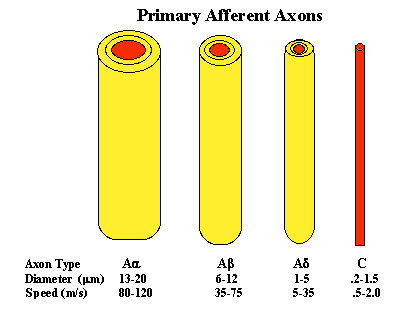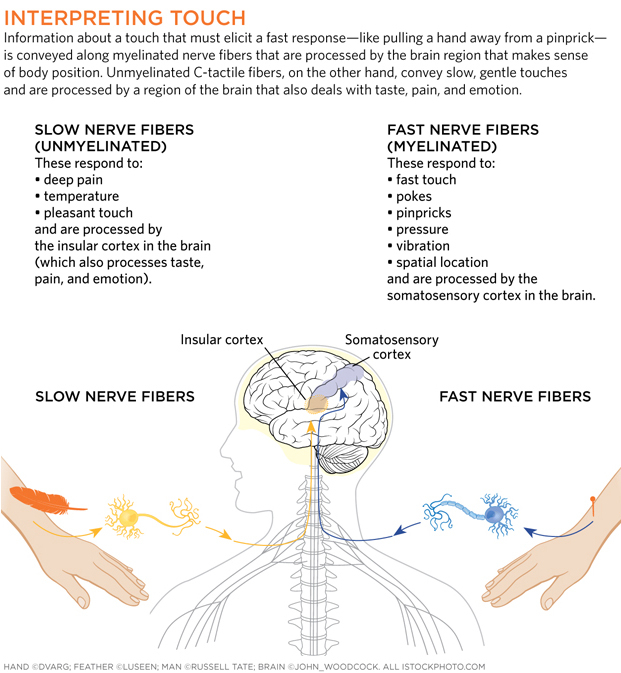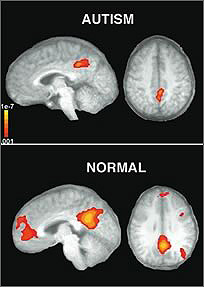Statement of Purpose
I have only a rudimentary knowledge of neuroscience, I would equate myself to a sophomore (2nd year) undergraduate in the subject. That being said, I was sitting in a lecture today and I noticed something I thought was interesting and decided to research it the rest of the day. As it turns out there was not much research in the subject, or at least not very Googleable(?) research. In posting this I am both explaining what I did find out, and hoping to either inspire someone to do this research or direct me to the research, because I find this fascinating.
Touch and Social Bonding
Today I listened to a presentation from a recent graduate from the University of Illinois Urbana-Champaign who was working on creating a device to stimulate CT afferents:
CT (C tactile) afferents are a distinct type of unmyelinated, low-threshold mechanoreceptive units existing in the hairy but not glabrous skin of humans and other mammals.
CT afferents have also been linked to social bonding and the research in this particular subject is relatively new. Further, and more importantly to this discussion CT afferents are unmyelinated, which essentially means there is no insulation around the axon. The image below are various fibers, the one all the way to the right would be the unmyelinated fiber:
The implication being the fiber will carry any signaling much slower than a myelinated axon. An analogy would be to imagine a myelinated series of axons being a paved road and an unmyelinated series of axons being an unpaved road, meaning a car (or signal) travels much slower.
Alright.. so what?
Well one thing that the presenter was working on was replicating results from previous studies to more or less “prove” that we evolved with CT afferent fibers to help support social bonding. What is interesting is that emotion is also associated with unmyelinated fibers [1], further individuals with autism are often have trouble controlling or sharing their emotions in a normal fashion [2]. Individuals with autism also have been shown to benefit from being brushed on the arm [3]. Where a large number of hair fibers are located, which is the only place CT afferent fibers are located in humans. It turns out that if many of our sensory neurons are not myelinated[4], most of which are associated with autisms issues (touch, emotions, hearing, etc.).
There is a fair amount of research on this subject as a Google Search will tell you. However, what much of the research I’ve been reading the past few hours has not seemed to connect is the connection between the unmyelinated fibers being (usually being) slow and autistic individuals issue with overstimulation (there was one paper). Nor that CT afferent fibers are connected with social contact and the (often) socially distant autistic individuals. My postulate being there is a connection, a single underlying cause, between all these various issues. I believe it is possible if not likely that all of these issues are derived from myelination issues and needs to be researched further.
Brains Scan Comparison
From:
Touching and feeling: differences in pleasant touch processing between glabrous and hairy skin in humans
Image representative of being stroked by a brush on the right arm:

How the signal travels though are slightly different:
Now, if we overlay that with the following from hahealth.com:
It is clear there is a difference between those with autism and the “normal” individual above, but to be honest I do not trust the validity of much of the imaging out there. The past hour I have looking at studies, etc. and they rarely have more than one or two brain scans, that’s simply not enough. However, many of the scans did show something similar to the image above, where autistic individuals have less activity in that particular region.
If we then review what we “know” from “normal” brains, we know that Insular cortex is the primary collection point for unmyelinated axons and myelinated axon signals are sent to the Somatosensory cortex. Interestingly, the Somatosensory region also is less active in those with autism (at least that is what it seems like, but again I question the validity). This could further support the myelination issue I postulated.
Summary
I hope that this is being looked into, I believe a single/multiple genetic mutation(s) could be at work to cause this, but the effect would be fairly easy to test via an autopsy or perhaps a sampling of nerve fibers in the arm. It seems to me, that the insular cortex seems to be at the “heart” of the problem, and although I am sure this has been researched CT afferent fibers have only just been discovered in humans (according to the lecture I attended today) in the 90’s and have not been researched thoroughly. To support that claim, I would like to point out most of the research I found on the subject was from 2009 – 2014.
As an aside, thank god I am still at a University. Most of this information is horribly inaccessible without access to research journals.



